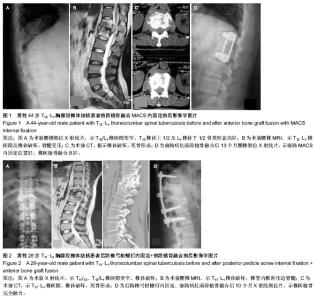| [1] Zhao J,Lian XF,Hou TS,et al. Anterior debridement and bone grafting of spinal tuberculosis with one-stage instrumentation anteriorly or posteriorly. Int Orthop. 2007;31(6):859-863.
[2] 李健,钟志宏,张平,等.椎弓根螺钉置入内固定联合自体颗粒骨移植治疗退行性腰椎病变[J].中国组织工程研究与临床康复,2010, 14(13):2421-2424.
[3] 王飞,倪斌,刘军.一期前路病灶清除钛网植骨内固定术治疗胸椎及胸腰段结核[J].中国脊柱脊髓杂志,2010, 20(5):390-394.
[4] 王文军,曾盛俊,刘利乐,等.前路病灶清除、钛网植骨重建治疗胸腰椎结核[J].中国脊柱脊髓杂志,2004,14(12):732-734.
[5] Rajasekaran S,Rishi Muqesh Kanna P,Shetty AP.Closing-open-ing wedge osteotomy for severe, rigid, thoracolumbar post-tubercular kyphosis.Eur Spine J.2011;20 (3):343-348.
[6] 张光铂,吴启秋.脊柱结核病学[M].北京:人民军医出版社,2007: 219-220.
[7] 霍洪军,邢文华,杨学军,等.脊柱结核手术治疗方式的选择[J].中国脊柱脊髓杂志,2011, 21(10):819-824.
[8] Bezer M,Kucukdurmaz F,Guven O.Transpedicular decancellation osteotomy in the treatment of posttuberculous kyphosis.J Spinal Disord Tech. 2007;20(3):209-215.
[9] 李建明,付新民,韩丽.经胸膜外腹膜后入路治疗胸腰段脊柱爆裂性骨折[J].中国骨与关节损伤杂志,2006,21(2):126-127.
[10] 张嘉利,李大伟,马远征,等.多节段胸腰椎脊柱结核外科治疗的回顾性研究[J].中国防痨杂志,2013,35(5):305-308.
[11] 马远征,薛海滨.脊柱结核的外科治疗策略[J].中国脊柱脊髓杂志, 2009,19(11):805-807.
[12] 孔维清,徐建广,周蔚,等.一期前后路联合手术治疗多节段胸腰椎结核[J].脊柱外科杂志, 2009,7(3):135-138.
[13] 周炜,李立钧,谭军,等.侧前方入路Ⅰ期病灶清除植骨融合加内固定术治疗胸腰段结40例[J].现代中西医结合杂志,2010,19(8): 958-960.
[14] 王锡阳,魏伟强,李伟伟,等.一期后路病灶清除植骨融合内固定治疗胸腰椎结核[J].中国脊柱脊髓杂志,2009,19(11):813-817.
[15] Lenke LG,Sides BA,Koester LA,et al.Vertebral column resection for the treatment of severe spinal deformity.Clin Orthop Relat Res. 2010;468(3):687-699.
[16] Wang Y,Zhang Y,Zhang X,et al.A single posterior approach for multilevel modified vertebral column resection in adults with severe rigid congenital kyphoscoliosis:a retrospective study of 13 cases. Eur Spine J.2008;17(3):361-372.
[17] Jin DD,Qu DB,Chen JT,et al.One-stage anterior underbody auto grafting and instrumentation in primary surgical management of thoracolumbar spinal tuberculosis. Eur Spine J. 2004;13(2):114-121.
[18] Alicioglu B,Sut N. Synovial cysts of the lumbar facet joints: a retrospective magnetic resonance imaging study investigating their relation with degenerative spondylolisthesis. Prague Med Rep. 2009; 11(4): 301-309.
[19] 王自立.进一步规范脊柱结核的治疗[J].中国脊柱脊髓杂志,2010, 20(10):793-794.
[20] Jain AK,Dhammi IK.Tuberculosis of the spine:a review. Clin Orthop Relat Res. 2007;460:39-49.
[21] 肖联平,江毅,田永刚,等.前路经腹腔一期病灶清除植骨融合内固定术治疗腰骶段脊柱结核[J].中国修复重建外科杂志,2009, 23(8):913-916.
[22] Metellus P,Fuentes S,Adetchessi T,et al.Retrospective study of 77 patients harbouring lumbar synovial cysts:functional and neuro-logical outcome.Acta Neurochirurgica. 2006;22(1): 47-54.
[23] Swartz PG,Murtagh FR.Spontaneous resolution of an intraspinal synovial cyst. Am J Neuroradiol. 2003;6(15): 1261-1263.
[24] Shah RV, Lutz GE. Lumbar intraspinal synovial cysts: conservative management and review of the world’s literature. Spine J. 2003;6(12):479-488.
[25] Sauvage P,Grimault L,Ben Salem D,et al. Lumbar intraspinal syno- vial cysts: imaging and treatment by percutaneous injection. Report of thirteen cases. J Radiol. 2000;1(22): 33-38.
[26] 崔旭,马远征,陈兴,等.脊柱结核前后路不同术式的选择及其疗效[J].中国脊柱脊髓杂志, 2011,21(10):807-812.
[27] 吴江群,李子荣,程立明,等.一期前路病灶清除植骨内固定治疗脊柱结核[J].临床骨科杂志,2008,11(4):318-320.
[28] 邵川强,王文己.脊柱结核的外科治疗进展[J].中国矫形外科杂志, 2012,20(3):245-247.
[29] 王学文,蔡程,郑海龙.前后联合手术治疗脊柱胸腰段结核[J].中国脊柱脊髓杂志,2009, 19(8):636-637.
[30] Landi A,Marotta N,Tarantino R,et al. Microsurgical excision without fusion asa safe option for resection of synovial cyst of thelumbar spine: long-term follow-up in mono-institutional experience. Neurosurg Rev. 2012;2:245-253.
[31] 秦毅,李勇,李振宇,等.微创后路固定联合前路病灶清除植骨融合治疗胸腰段脊柱结核[J].中国矫形外科杂志,2014,22(7): 659-661.
[32] Sandhu FA,Santiago P,Richard G,et al. Minimally invasive surgi-cal treatment of lumbar synovial cysts. Neurosurgery. 2004;54(12):107-112.
[33] 徐大启,王锡阳,葛磊,等.后路经椎弓根病灶清除、自体及同种异体骨植骨融合并节段性内固定治疗胸腰椎结核[J].中国组织工程研究与临床康复,2009,13(22):4349-4354.
[34] Moon MS,Moon YW,Moon JL,et al. Conservative treatment of tuberculosis of the lumbar and lumbosacral spine. Clin Orthop Relat Res. 2002;(398):40-49.
[35] 何思敏,卢代刚.前后路联合手术治疗下腰椎结核[J].实用医学杂志,2006,22(14):1641-1642.
[36] Cavusoglu H,Kaya RA,Turkmenoglu ON,et al. A long term follow up study of anterior tibial allografting and instrumentation in the management of thoracolumbar tuberculous spondylitis.J Neurosurg Spine. 2008;21(1):30-38.
[37] 施向春.不同植入体置入内固定在胸腰椎结核治疗中的应用[J]. 中国组织工程研究与临床康复,2010,14(35):6591-6595.
[38] 马维虎,孙韶华,徐荣明,等.一期病椎切除内固定治疗胸腰段脊柱结核[J].临床骨科杂志, 2008,11(2):112-114.
[39] Shimode M,Kojima T,Sowa K. Spinal wedge osteotomy by a single posterior approach for correction of severe and rigid kyphosis or kyphoscoliosis.Spine. 2002;27(20):2260-2267.
[40] Turgut M. Spinal tuberculosis (Pott's disease):its clinical presentation,surgical management,and outcome. A survey study on 694 patients. Neurosurg Rev. 2001;24(1):8-13. |

